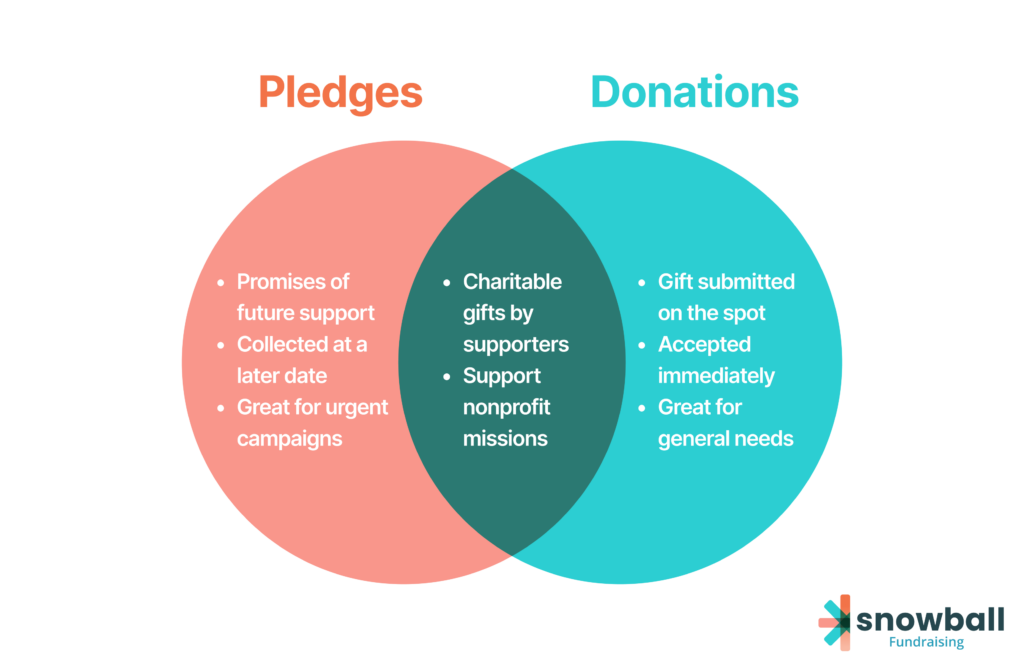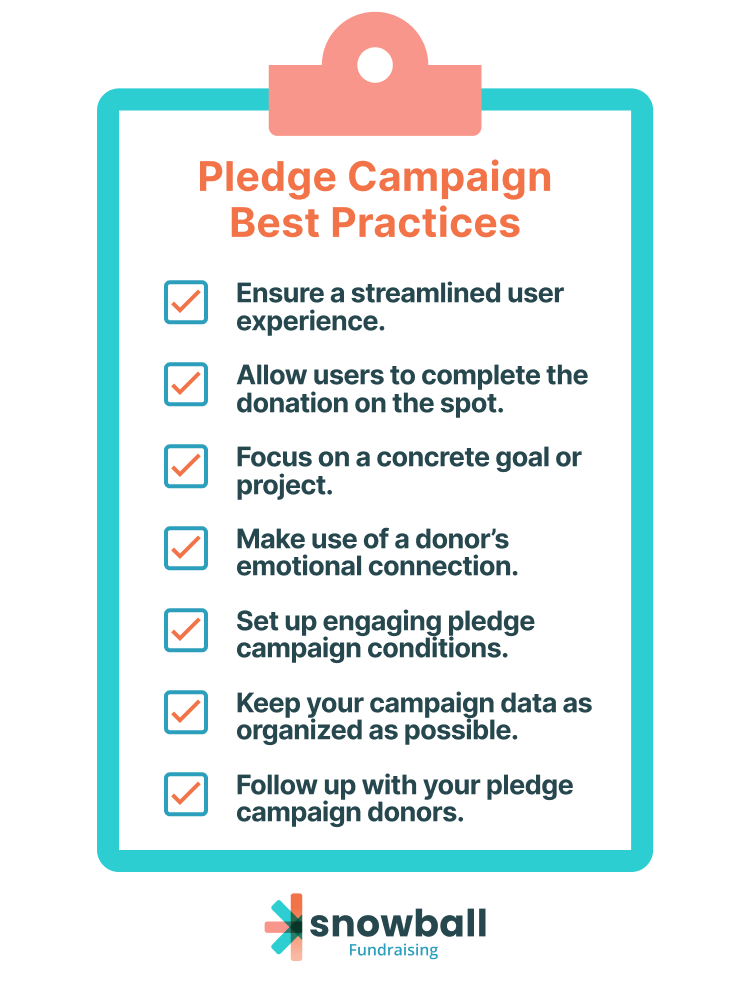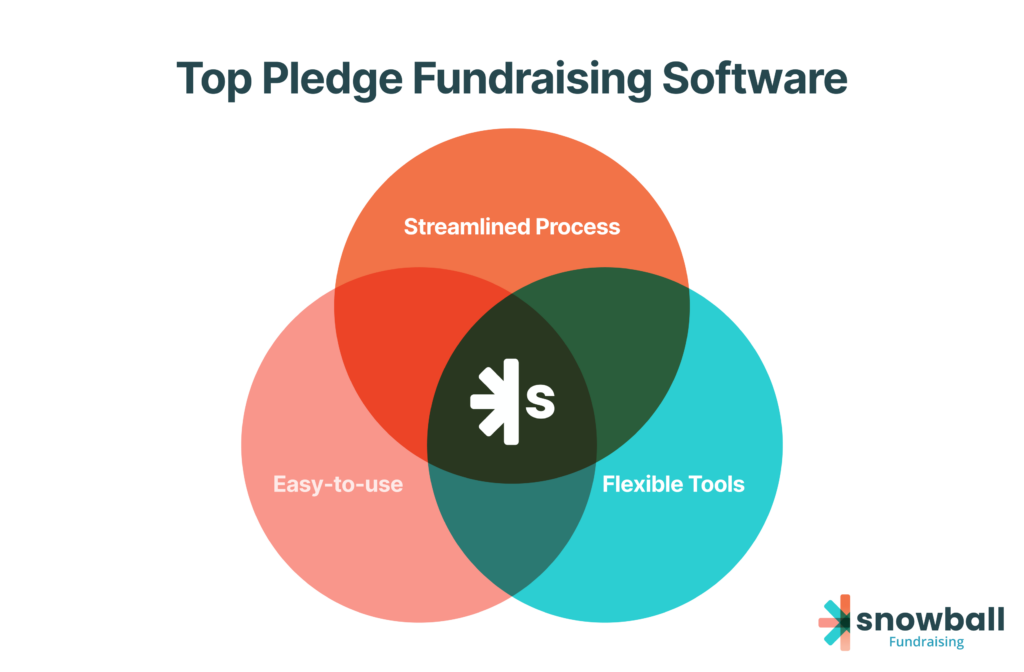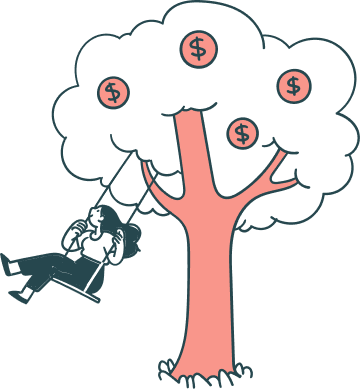Fundraising is an important (if not the most important) activity that nonprofit organizations must conduct on a continual basis. Yet finding new strategies, donation tools, and engagement techniques can be a struggle— especially while adapting to changing times.
Even as you attract and retain a pool of devoted donors, volunteers, and supporters, it’s crucial that you continue to grow your base of support. After all, reaching new donors is an essential part of pursuing and expanding your mission.
That’s where pledge fundraising comes in! Launching a pledge campaign can generate a lot of support for your cause quickly, but it does require forethought and planning. That’s why we’ve created this ultimate guide to prepare you for your first (or next!) pledge campaign. Here are three of the most-asked questions to get started:
- What’s the Difference Between Pledges and Donations?
- What are Some Pledge Campaign Best Practices?
- How Do I Choose the Right Pledge Fundraising Software?
Feel free to skip around to the sections that interest you most, or read along from the top as we walk through basic terminology, best practices, and suggested tools for a powerful pledge fundraiser. Let’s jump in!

1. What’s the Difference Between Pledges and Donations?
Getting started, it’s important to have a solid understanding of the similarities and differences between fundraising pledges and typical donations. Both types of gifts are made by supporters who believe in your mission and the goals of your campaign, and both can financially support your nonprofit’s operations.
However, the ways in which you structure your campaigns and solicit each type of donation are fundamentally different, as illustrated by this diagram:

Fundraising pledges:
- Are promised support of pledged funding to be paid and processed in the future.
- Require carefully-developed pledge campaigns that include specific timeframes and conditions.
- Work best for urgent needs such as disaster relief, unexpected expenses, and advocacy work.
Traditional donations:
- Are accepted immediately, all across the duration of the fundraising campaign.
- Can usually be accepted at any time, but most typically during a campaign with clearly-defined goals.
- Work well for evergreen needs such as classic fundraisers and general programming expenses.
What unites these two donation styles— fundraising pledges and traditional donations— is the need for a compelling case for support. Donors must feel emotionally compelled to give you their support either as a pledge or a direct donation.
However, this is especially important for pledge campaigns. Since the idea is to quickly collect promises of support, maintaining energy and momentum is key. An emotionally or socially compelling mission will encourage quick action and take your pledge campaigns to the next level.
Your mission, project, fundraising goals, and time constraints will all play into the development of an effective pledge campaign by boosting urgency and creating compelling pledge conditions.
After all, it’s easier to convince supporters to pledge a donation rather than ask them to immediately part with their money. And since the majority of pledges are fulfilled, by offering pledges as an option you’ll secure more gifts overall than if you only accepted immediate donations.
Look at it this way:
Out of 1,000 potential donors, 900 chose to pledge a donation using a pledge-style fundraising page. Of those 900, 85% of them followed through to complete their pledged donations. That’s 765 completed donations!
Compare this to traditional donation pages — only about 250 out of 1,000 potential donors actually bother to complete the donation process at all. You leave a ton of money on the table that way.
Let’s say each of these donors makes a gift of $125. With traditional donation pages, that gives you $31,250. With pledge software, you raise a whopping $95,625.

2. What Are Some Pledge Campaign Best Practices?
If this is your first time hosting a pledge fundraiser, it may seem a bit overwhelming. However, by implementing a few simple best practices, you’ll be ready to get started in no time. Let’s check out our top seven tried-and-true pledge fundraising tips!
1. Ensure a streamlined user experience.
Hosting a pledge campaign requires pledge-specific tools designed to help nonprofits like yours meet their goals. Be sure to focus on providing a streamlined user experience and flexible options. That’s because making it faster and easier to pledge support is the key to success.
A streamlined user experience allows you to keep your donors in the giving mood, shows respect for the individual’s time and effort, and reduces the opportunities for donation form abandonment. On the other hand, slowing the process down by requiring any more data input than necessary will actively harm your campaign.

2. Allow users to complete the donation on the spot.
Make sure your donation and pledge platforms offer the option to complete an immediate donation if your supporter chooses to do so. For example, Snowball’s pledge fundraising platform allows each donor to decide whether to make a quick pledge or complete their donation right then and there— providing an increased sense of control over the entire experience.
3. Focus on a concrete goal or project.
Pledge campaigns are the most effective when built around a specific goal or project. This allows donors to know exactly where their gifts are going and provide a sense of urgency for your organization to reach your goal.
Examples of central goals or projects that regularly motivate pledge supporters include:
- Disaster relief for local, national, and international crises, like hurricanes or the COVID-19 pandemic
- Fundraising for advocacy or community work around a specific social or political issue
- Buying your nonprofit’s rented facilities or offices to secure your future
- Covering surprise major expenses your nonprofit has experienced
- Raising support for a new major program or community project
It helps to have a specific number as your fundraising goal, and allow donors to keep up with your progress with tools like your fundraising thermometers.
4. Make use of a donor’s emotional connection.
Of course, nonprofits of all sizes also find success using pledge campaigns to boost their annual fund drives. It’s always possible to build a pledge campaign around a less urgent or high-stakes goal, but it requires a slightly different approach.
In these cases, make sure that your annual fund pledge drive taps into an emotional connection that your donors feel with your organization. Compel your donors to pledge their support out of a sense of responsibility, love for community, and attachment to your work.
Get creative when highlighting your recent accomplishments! An annual drive focused on sustaining your growth could be a strong motivator for your devoted base of support.
5. Set up engaging pledge campaign conditions.
Pledge campaigns can come in all shapes and sizes, so it’s important to set clear guidelines beforehand. For example, you’ll want to arrange:
- A tight deadline. A definite endpoint within sight is essential for keeping up campaign energy. Use your fundraising thermometer on your campaign page and email communications for sustained impact.
- Pledge triggers. Pledges are activated and eligible for collection only when specific goals are met, like reaching a total amount pledged, signatures received, or major gifts secured. Creating a strong sense of group effort in this way can really bring your community together.
- Matching periods. Discuss arranging a special gift matching period with one of your major donors or corporate sponsors. Every pledge you receive during a chosen short period of time will be matched for double the impact.
This will allow your organization to plan a better fundraiser and your supporters to understand what they’re agreeing to.
6. Keep your campaign data as organized as possible.
Every fundraising campaign requires some tidy data practices, but this is especially true for pledge drives. After all, your wealth of campaign data can assist you in tracking your fundraising progress, following up and collecting funds, reaching out to new donors, and analyzing trends.
However, you don’t want to get too caught up in data collection that you slow down the pledge process. Make sure that you’re only asking supporters for the bare minimum needed to follow up later— such as their name, email address, phone number, and pledge amount.
Using effective fundraising software for your pledge campaign ensures your data is collected and sorted properly as it’s generated, which will dramatically simplify collecting your pledges later!
7. Follow up with your pledge campaign donors.
Your team’s ability to follow up with supporters at the conclusion of your fundraiser is what ultimately results in a successful pledge campaign. After all, even if you hit your pledge goal, you have to actually collect the funds to make an impact.
When it’s time to follow up, be sure to take a systematic approach to collect pledges. A standardized script for letters, emails, and phone calls will yield better results than an ad hoc or individualized process. Past due pledges are often the result of forgetfulness, so a polite reminder or two can go a long way.
Now that you know how to get started with a pledge fundraiser, it’s important that you select the right tools to bring about desired results.

Take a Personalized Tour
Schedule a demo with one of our fundraising consultants. We’ll show you how the Snowball platform has benefited other nonprofit organizations, and how it can help you.


3. How Do I Choose the Right Pledge Fundraising Software?
If you’ve never conducted a pledge drive before, you might be unfamiliar with what to look for in an online or mobile pledge tool. There are a few key characteristics to prioritize during your search— speed, ease of use, and flexibility.
Pledge fundraising software should provide a fast, streamlined process.
Remember that the core purpose of a pledge drive is to secure pledged support and contact information — that’s all you need. Asking for anything more than that will drive away potential supporters right off the bat. The faster the process, the fewer opportunities for your donor to drop out and abandon the pledge.
Effective pledge software will help you quickly secure support while strengthening your pledger’s emotional connection with your cause. For best results, look for software that lets you secure a card on file and set up a recurring donation for continued support.
Pledge fundraising software should be easy-to-use for you and your donors.
Just like too many required fields and a lengthy donation process can lead to increased donation form abandonment, so can an unnecessarily complicated or difficult to navigate one. That’s why it’s just as crucial that your fundraising software employs an easy-to-use pledge process.
Be sure to optimize both the initial pledge process as well as the follow-up and payment collection processes. For example, automatic donor communication tools should provide each user with step-by-step instructions and a link to the final payment form.
Pledge fundraising software should offer flexible options.
When you employ a pledge fundraising tool with increasingly flexible capabilities, you allow your supporters to personalize their own donation experience to what suits them best. For example, make sure your supporters have the choices to:
- Complete the donation right away. Never force your pledgers to complete their donation — that would defeat the whole purpose. However, offering the choice to enter their payment info after submitting the pledge is an easy way to secure more support and boost donor engagement.
- Select a method of payment. Offering multiple choices for payments provides an increasingly convenient donor experience. That way, each supporter can choose the form that works best for them— the most popular being credit card and ACH payments.
- Set a communication preference. When you encourage donors to select their preferred method of communication right off the bat, you increase the likelihood that you’ll be able to keep in touch with them after the fundraiser ends.
Ideally, your pledge software will come as part of a larger suite of donation tools that can be adapted for different purposes. Look for a donation platform that offers core donation functions, pledge fundraising options, and even text-to-give tools. With more features available, you can fine-tune your strategies to keep the process focused on the donor’s experience.
The Best Choice for Pledge Fundraising Software
Here at Snowball, our mission is to provide more nonprofits with the tools they need to build relationships with new and existing donors. We prioritize speed and optimized user experience to ensure that supporters stay focused on your mission rather than get distracted or turned off by the process itself.
Our core fundraising philosophy boils down to 3 core steps:
1. Don’t kill the donor’s buzz.
2. Master the art of securing a card.
3. Focus on recurring donors.
Pledge drives and pledge software are perfectly suited for the first step — don’t kill the donor’s buzz.

That’s why Snowball’s mobile fundraising pledge software is a great example of a flexible tool that prioritizes user experience. Built on Snowball’s complete suite of lightning-fast 2-click giving platform, this pledge tool secures support for your campaign quickly and easily. Plus, it automatically follows up and allows supporters the option to easily complete their pledged donations afterward!
Wrapping Up
Hosting a pledge fundraiser is a great way to drum up support for your organization— from new and existing donors alike. By leveraging an emotional connection to your organization and the urgency surrounding your mission, you can engage with supporters in a unique and exciting way.
For more information, check out our top fundraising resources for nonprofits like yours:
- Free Fundraising Software For Nonprofits: 15+ Top Providers. Getting up and running with effective fundraising tools doesn’t have to break the bank. Check out our favorite free providers here.
- Text-To-Give | Complete Guide For Nonprofits And Fundraisers. Mobile giving tools allow donors to give on-the-go anytime they want. Find out how to use text-to-give to bring increased convenience to your donors and increased funds to your organization.
- Virtual Fundraising: The Complete Guide For 2020 & Beyond. As nonprofits everywhere shift to increasingly digital practices, it’s important that you don’t get left behind. Learn more about modern virtual fundraising strategies here.



